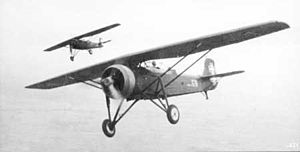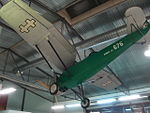
The Focke-Wulf Fw 58 Weihe (Harrier) was a German aircraft, built to fill a request by the Luftwaffe for a multi-role aircraft, to be used as an advanced trainer for pilots, gunners and radio operators.

The PZL.23 Karaś was a Polish light bomber and reconnaissance aircraft designed in the mid-1930s by PZL in Warsaw.

The Albatros C.III was a twin-seat general-purpose biplane designed and produced by the German aircraft manufacturer Albatros Flugzeugwerke. It was produced in greater numbers than any other C-type aircraft by Albatros as well as being the company's most-produced twin-seat aircraft.

The Lithuanian Air Force or LAF is the military aviation branch of the Lithuanian armed forces. It is formed from professional military servicemen and non-military personnel. Units are located at Zokniai Air Base near the city Šiauliai, at Radviliškis and Kaunas.

Jurgis Dobkevičius was a pioneering aviator and aircraft designer in interwar Lithuania.
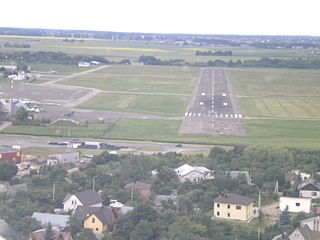
S. Darius and S. Girėnas Airport, also known as Aleksotas Airport, is a small airport located in Aleksotas district of Kaunas City (Lithuania), about 3 kilometres South-west from city centre. On May 6, 1993, the airport was named after the Lithuanian pilots Steponas Darius and Stasys Girėnas, who perished in a crash near the end of an attempted non-stop flight from New York to Lithuania in 1933.

The Bücker Bü 133 Jungmeister was an advanced trainer of the Luftwaffe in the 1930s. It was a single-engine, single-seat biplane of wood and tubular steel construction and covered in fabric.

The ANBO I was a single-seat aircraft developed in Lithuania, proposed as a trainer for the Army It was a low-wing, braced monoplane of conventional tailwheel configuration. The fuselage structure was of fabric-covered welded steel tube, The wing had a wooden, two-spar structure and was fabric covered but the fuselage, also fabric covered, had a welded steel tube structure.
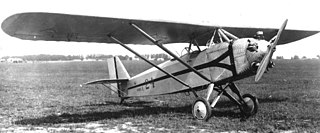
The ANBO II was a parasol-wing monoplane aircraft built in Lithuania in 1927 as a pilot trainer for the Army. It was the first Lithuanian trainer aircraft of own design. It was eventually reequipped with more powerful engine for the Aero Club of Lithuania in 1931 before being written off after a crash in 1934.
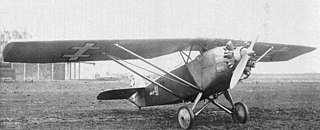
The ANBO III was a parasol-wing monoplane training and utility aircraft designed for the Lithuanian Army in 1929. It became the first aircraft of Lithuanian design to be built in series, with two batches of four aircraft produced in 1930 and 1931. The ANBO IIIs also saw service as reconnaissance machines.
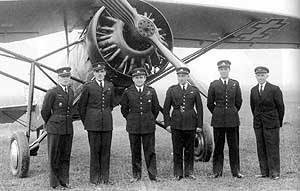
The ANBO V was a parasol wing monoplane training aircraft designed for the Lithuanian Army in 1931. A developed version, the ANBO 51 followed in 1936 and 1938.

Antanas Gustaitis was a Brigadier General in the Lithuanian Armed Forces who modernized the Lithuanian Air Force, which at that time was part of the Lithuanian Army. He was the architect or aeronautical engineer who undertook the task to design and construct several military trainers and reconnaissance aircraft.

Karo Aviacijos Tiekimo Skyrius was the Army Aviation Workshops of Lithuania, established at Kaunas. The facility was considerably modernized under the leadership of Antanas Gustaitis, who also designed a variety of aircraft to be built there in small series in the 1920s and 1930s under the designation ANBO.

The Halberstadt C.V was a German single-engined reconnaissance biplane of World War I, built by Halberstädter Flugzeugwerke. Derived from the Halberstadt C.III, with a more powerful supercharged 160 kW (220 hp) Benz Bz.IVü engine, it saw service only in the final months of the war. Cameras were mounted in the observer's cockpit floor.

Entering service in 1915, the Rumpler C.I,, two-seater single-engine reconnaissance biplane, was one of the first German C-type aircraft, and also one of the longest serving in its class during World War I, being retired from the last front line units only in early 1918.

The DFW C.IV, DFW C.V, DFW C.VI, and DFW F37 were a family of German reconnaissance aircraft first used in 1916 in World War I. They were conventionally configured biplanes with unequal-span unstaggered wings and seating for the pilot and observer in tandem, open cockpits. Like the DFW C.II before them, these aircraft seated the gunner to the rear and armed him with a machine gun on a ring mount. Compared to preceding B- and C-class designs by DFW, however, the aerodynamics of the fuselage were more refined, and when coupled with more powerful engines, resulted in a machine with excellent performance.

The Heinkel HE 5, produced in Sweden as the Svenska S 5 and nicknamed the "Hansa", was a reconnaissance floatplane built during the 1920s. It was a further development of the HE 1, sharing its same basic configuration as a low-wing, strut-braced monoplane. The HE designation also refers to the monoplane construction, standing for Heinkel Eindecker.

The ANBO VIII was a Lithuanian bomber-reconnaissance monoplane designed by Antanas Gustaitis and built by Karo Aviacijos Tiekimo Skyrius.
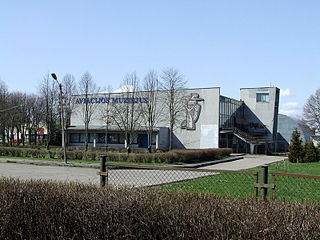
The Lithuanian Aviation Museum is located in Kaunas, Lithuania. The museum was officially opened in 1983. The permanent collection of the museum contains more than 18 000 displays of different fields of technology. The major part of the collection is dedicated to the history of aviation in Lithuania. It includes about 40 flying machines, models of airplanes, flyers, gliders and helicopters of various times, and designed during the Interwar period of Lithuania first combat aircraft the ANBO I by General Antanas Gustaitis.
Aeroclub of Lithuania is the national association of Lithuania’s civil aviation federations and air clubs. LAK, established in 1927 and re-established in 1989, it is one of the oldest non-governmental organisations of Lithuania.
